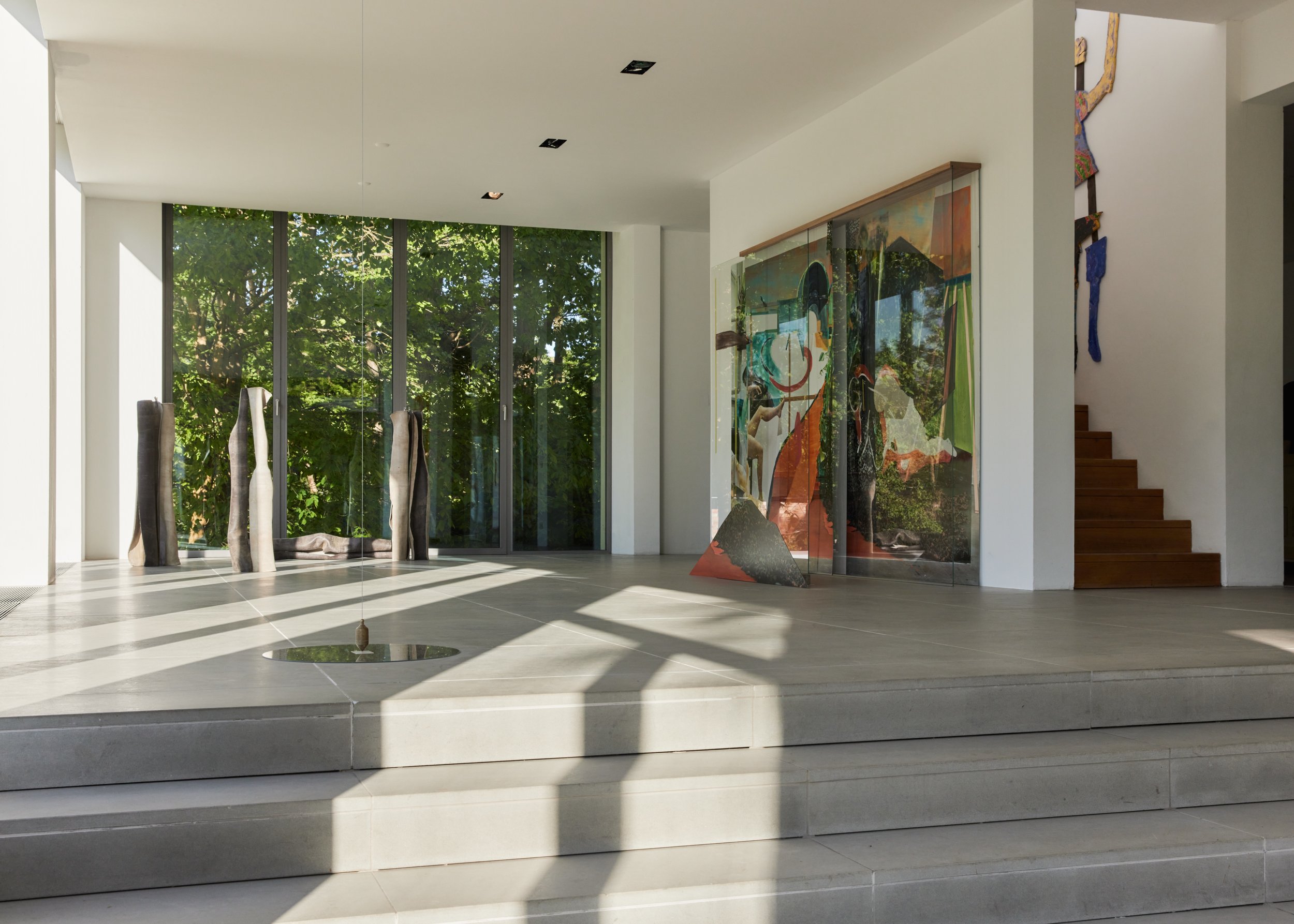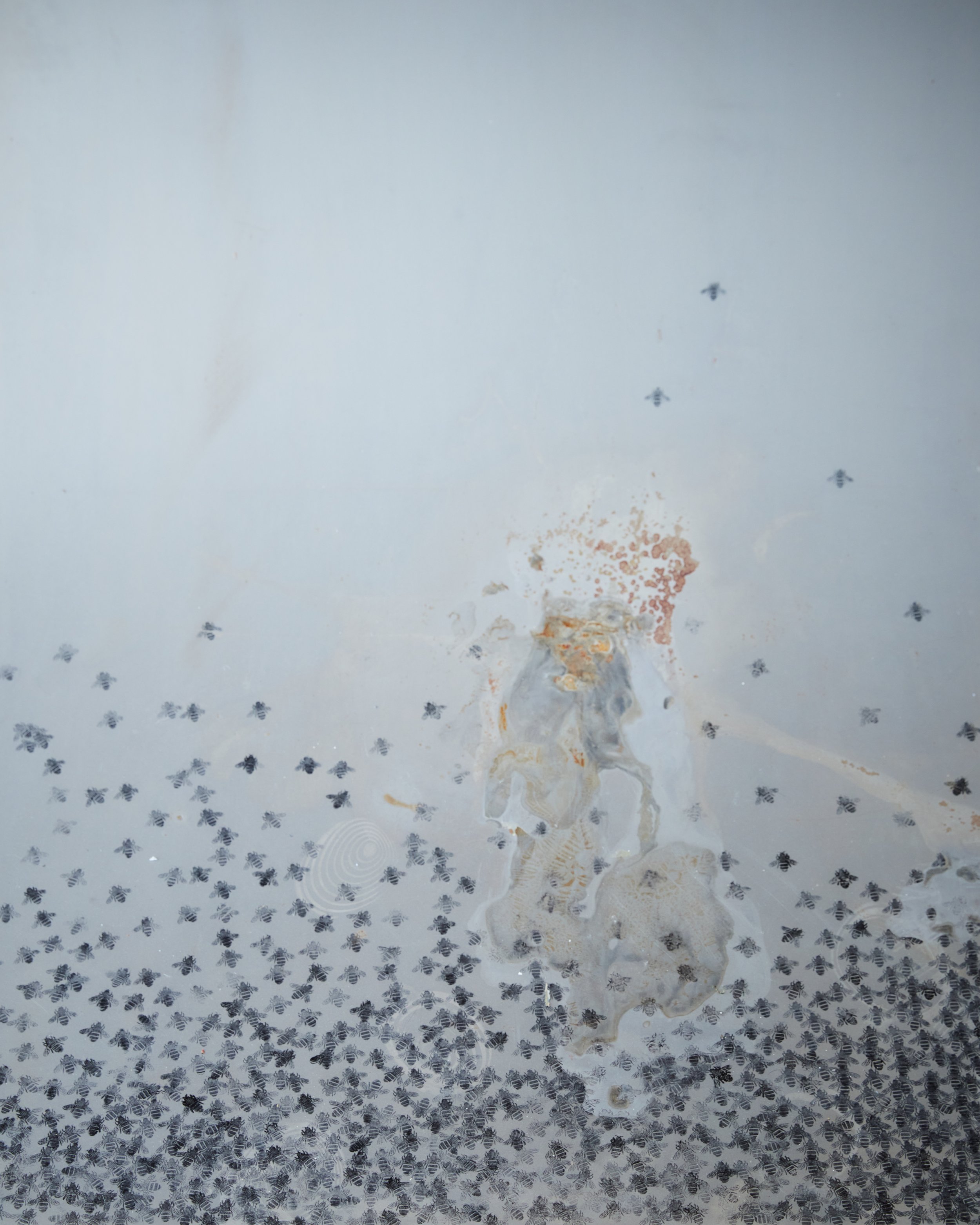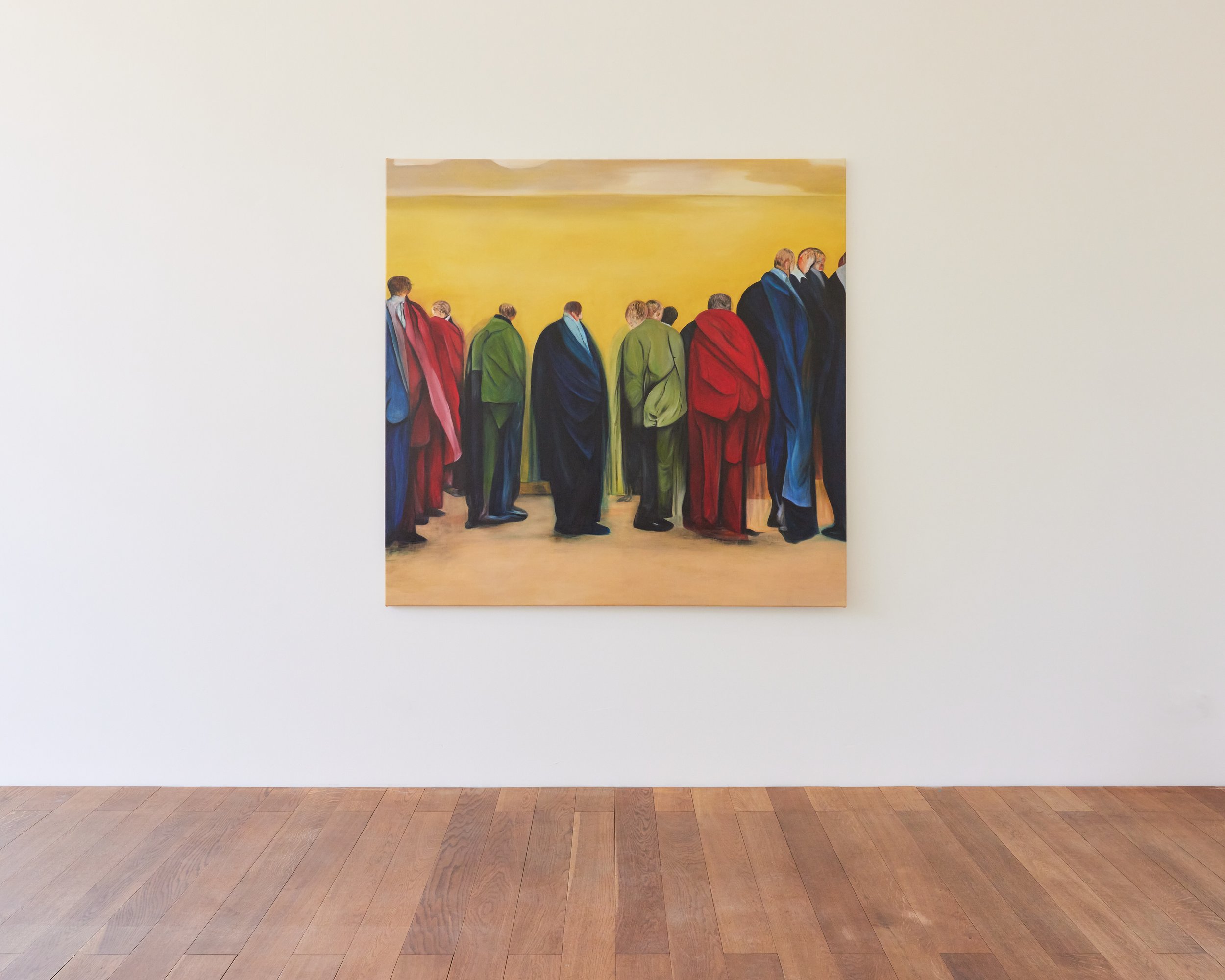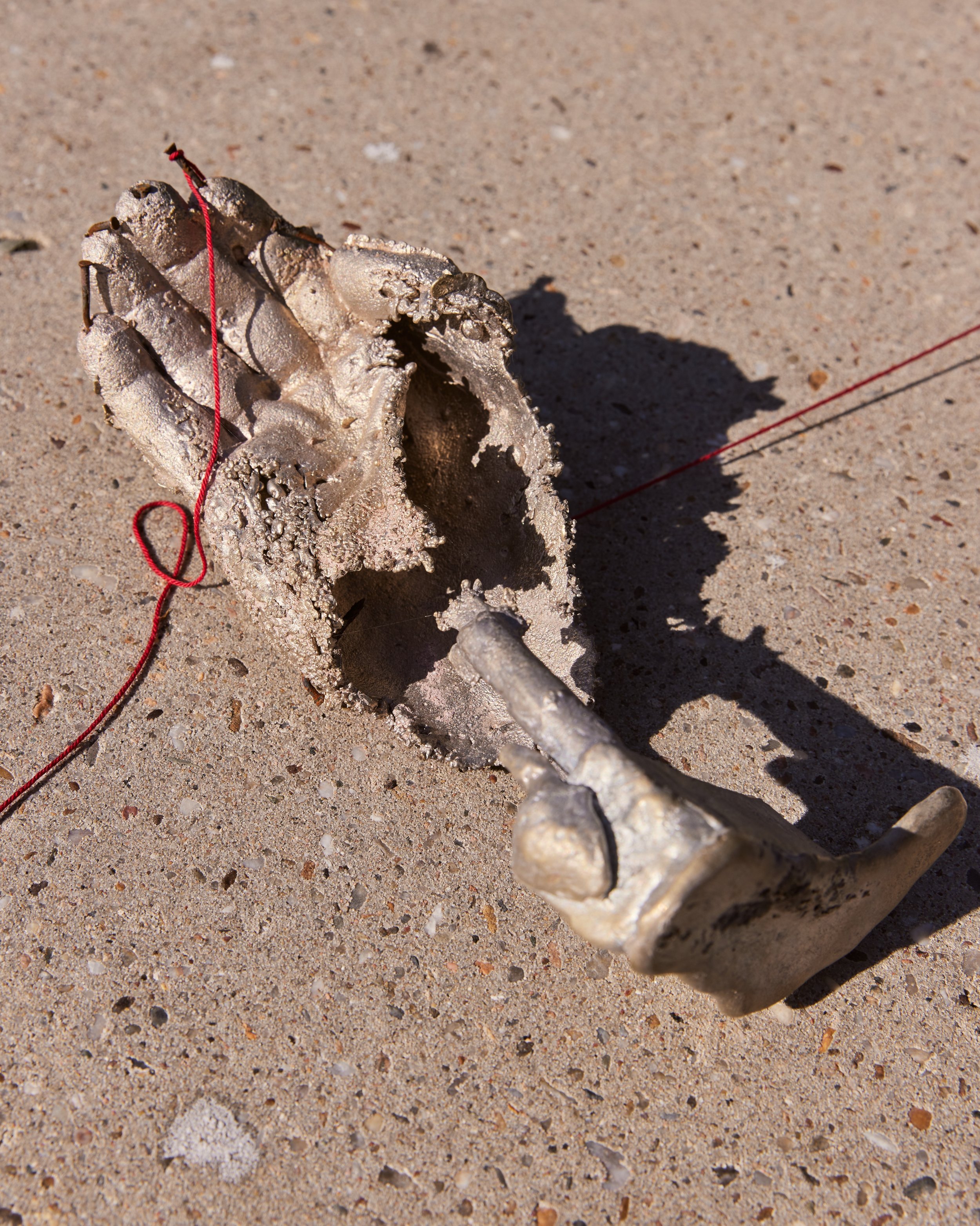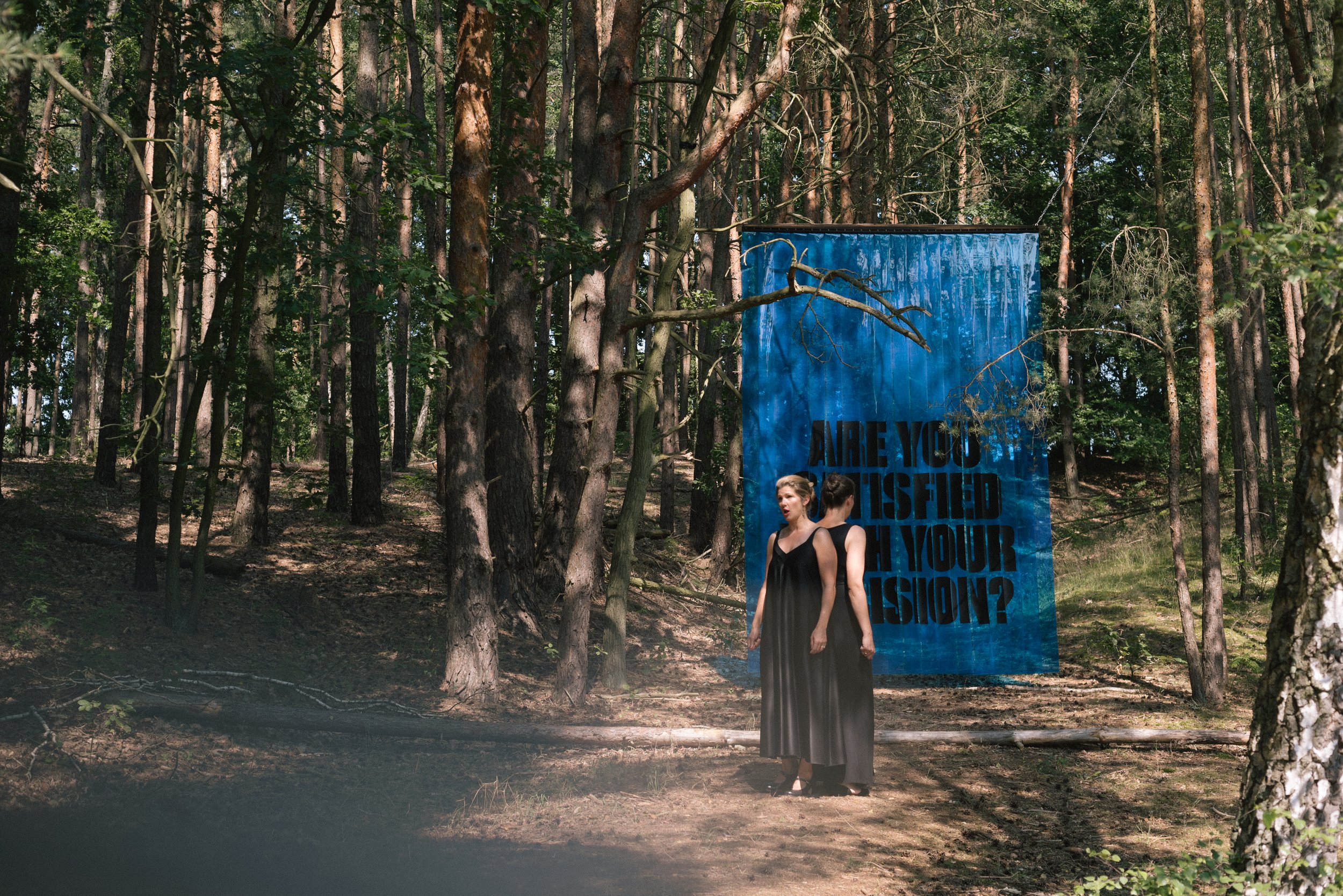REVERIES OF A SOLITARY MUSE
Group exhibition
Curated by Alexia Timmermans
January 30–March 8, 2025
Haverkampf Leistenschneider Mommsenstraße 67, 10629 Berlin
In Greek mythology, the Muses were thought to speak in whispers, inspiring those they blessed with their gifts. In some accounts, these whispers were carried on the wind, often from Mount Helicon, the sacred mountain where the nine Muses were said to reside. As divine patrons of the arts, each Muse presided over a distinct domain of knowledge—spanning poetry, dance, music, history, and astronomy—collectively embodying the vast spectrum of human inspiration, guiding artists, poets, and musicians as they retreated into the depths of thought.
This idea of whispers has transcended time, enduring as a metaphor for the muse’s mysterious aura, a source of inspiration and personal enlightenment. Building on this notion, the exhibition reveries of a solitary muse brings together the work of nine women artists: Nadja Abt, Annabelle Agbo Godeau, Solweig de Barry, Isabella Fürnkäs, Suah Im, Alex Müller, Eglė Otto, Sophia Süßmilch, and Sophia Tabatadze. Spanning a wide range of mediums, their works offer multifaceted perspectives on the muse, unfolding a narrative imbued with a sense of dream, poetry, social critique and humour.
In some works, the muse emerges as a guiding principle—a mediator between the physical world and the realm of ideas—manifesting, for instance, through the artist’s dedication to a specific medium, where repetition becomes an inquiry into the essence and language of art itself. Others explore the concept through metaphors, allegories, mythological or cinematographic references, often placing the female figure or motifs traditionally associated with it at the centre of their iconography. Across their diverse practices, a common muse is grounded in the personal, in their roles as artists and women, while informed by varied cultural backgrounds.
Redefining the muse beyond its classical origins, the exhibition invites reflection on the enduring ambivalence surrounding its representation in contemporary culture. In Western art, the muse has historically been shaped by the male gaze—viewed as an object of inspiration rather than originator—and, since the late 19th century, often conflated with the ‘femme fatale’—an archetype of beauty, at once enchanting and threatening. In contrast, each artist reclaims the archetype for herself, subverting, directly or indirectly, the clichéd portrayal commonly tied to it.
CHANGE IN SUSPENSE
solo exhibition by Hannah Hallermann
Hosted by Stephanie Kloss
Curated by Alexia Timmermans
June 9–July 9, 2023
Die Möglichkeit einer Insel
Inselstraße 7
10179 Berlin
Life consists of conflicting forces that ideally hold each other in a creative tension but sometimes also tear relentlessly at each other. Tension has the potential to promote transformation and also implies the danger of stagnation or rupture.
Berlin artist Hannah Hallermann has found a sculptural language for these dynamics, which can be applied to materials as well as to socio-political developments. The exhibition in the Berlin project space Die Möglichkeit einer Insel shows a series of fictional tools that express the need to endure contradictions, to move between different frames of reference and to develop some kind of ambivalence competence. The sculptures are in a dialogue with wall works, which translate the tension into text form. “I feel challenged to show different perspectives and to question how elements from different systems can merge. This is usually followed by a call to help shape things.”, says Hannah Hallermann.
In the exhibition CHANGE IN SUSPENSE, objects remain in intermediate states, which deal with flexibility, but also with coercion and violence. Modular silicone elements function as buffer zones between metal modules, enabling compression and stretchability. Flexible use and the potential of their own changeability is virtually incorporated into the sculptural forms. Sculpture here does not mean stagnation, but the possibility of constant change. And how is it possible to allow ourself optimism and the will to succeed, without these categories immediately being appropriated by competitive pressures?
A hanging work from the series “Startblock” seems to suggest a state of suspension between hesitation and action. The minimal form of the object is closely linked to a narrative component. A starting block is a place of jumping off that encompasses different chances and different leaps of faith, a starting point where contradictory feelings accumulate and questions impose themselves.
The exhibition CHANGE IN SUSPENSE confronts us with open questions: How to constantly realign actions in a time of extreme change? What lies in a concentrated collective pause before the action? When is the right time to leap forward.
With text-material from Antonia Ruder, Saskia Trebing and Anka Ziefer
THE POET’S FOLLY AND THE SOVEREIGN’S HAND
Art Biesenthal 2023 | Group Exhibition
Curated by Alexia Timmermans
June 3–July 30, 2023
Wehrmuehle
Wehrmuehlenweg 8
16359 Berlin–Biesenthal
Folly has long fascinated as a subject. The fool has evolved as a metaphor conveying the dichotomy between insanity and common sense. While the fool may lack reason, it possesses hidden or prophetic wisdom that is unattainable to the sane. Its most prominent representation, perhaps, is that of a ship with a dysfunctional crew aimlessly crossing the ocean. The allegory of the ship of fools can be traced back to Plato's Republic, and by the sixteenth century, penetrated Western literature and visual arts, with notable works including Sebastian Brant's Das Narrenschiff (Ship of Fools), Hieronymus Bosch's The Cure of Folly, Erasmus of Rotterdam's In Praise of Folly, and more recently, Michel Foucault's Madness and Civilization, which has revived critical attention to this enduring theme.
The term ‘folly’ originates from the French word ‘folie’, which can refer to ‘madness’, ‘lack of good sense’, or ‘false belief’, but can also connote ‘delight’. Over time and across different cultural contexts, the meaning of folly has evolved, with interpretations often lying in the eye of the beholder. In theatre and architecture, follies are typically characterised by formal eccentricities and excesses, aiming at activating the viewer’s perspective. In visual arts, in turn, folly can convey expressions of imagination or self-definition, while also serving as an agent of truth that holds up a mirror to contemporary issues, including the very notion itself.
The exhibition The Poet’s Folly and the Sovereign’s Hand presents the work of 31 international artists who explore the multifaceted nature of folly, through mediums such as paint, sculpture, film, fabric, photography, performance and sound. Offering a critical reflection on the sovereign world of control and rationalism through the realm of human follies, the works on view address various topics which range from cultural clichés and archetypes, to established norms and beliefs, as well as rituals and myths of identity.
Overall, whether redefining the canonical idea of sanity, morality, or power, the works act as paraphrases of a continuous tension that exists between perception and pervasion, personal and historical narratives, cultural restoration and re-imagination. Through the prism of folly, the exhibition presents a view of the world that is at once disturbing and darkly comical, speculative and self-reflective, playful and psychologically charged.
Featuring works by Agnès Varda, Alicja Biala, Anastasia Bay, Annette Frick, Anri Sala, Antoine Waterkeyn, Cathrin Hoffmann, Emmanuel Bornstein, Etti Abergel, Hannah Hallermann, Heike Gallmeier, Jonas Brinker, Kaspar Müller, Laure Prouvost, Lukas Stöver, Marcelo Viquez, Marianne Berenhaut, Mirosław Bałka, Nora Aurrekoetxea, Oussama Tabti, Pauline Curnier Jardin, Paulo Wirz, Rafaella Braga, Sandra Vásquez de la Horra, Sarina Panahideh, Sebastian Lettner, Tong Kunniao, Ulla von Brandenburg, Ulrike Theusner, Verena Issel, Yudith Levin.
FALTVOGEL
a solo exhibition by Sebastian Lettner
Curated by Alexia Timmermans
In collaboration with NO’ONO’O
April 1–3, 2022
Eberswalderstr. 22
10437 Berlin
In his exhibition FALTVOGEL Sebastian Lettner portrays ‘the art of folding and unfolding’ in a range of works meandering on the border of abstraction and figuration. Including a large-scale 3 by 4 metres diptych, a wall composition of found objects, large plant drawings and smaller textile works, the presentation evokes at times dynamic, at others more silent echos of nature – a recurrent theme in Lettner’s work.
Faltfogel, ‘folded bird’ – title of the exhibition and recently published poetry book – refers to Lettner’s practice of bringing together different mediums like painting, drawing, installation and writing. Like in his poetry, where disparate thoughts, concepts and words create new meanings by overlapping or merging them, in the works on view Lettner generates new perspectives by superimposing gestures, blending textures or folding materials. Working with found material, building pictures out of leftovers, is an important part of that procedure.
The series of paper works – drawings of (decaying) plants, flowers or other flora, epitomises Sebastian Lettner’s aptitude for formal play and spontaneity, as manifested by a reduced pictorial vocabulary of varying expressive character. A continuation of his major body of work comprising painting, in this recent work Lettner uses the oilbar as a medium to break down the barrier between drawing and painting as well as a method of coincidence – this is, by letting his gestures be guided by haphazard marks of oilbar incapable of being erased. Another technique used to highlight the process of coincidence is the folding and unfolding of each sheet of paper. Other than the inkblot technique (Rorschach), where the pressing of an ink drawing will leave a symmetrical pattern across both halves of the sheet, Lettner makes us of the opaque quality of oilbar to only transfer a thin layer of colour to the other half. These sporadic traces of tincture serve him as minimal reference points to intuitively reproduce the original pattern.
Coincidence and reduction are also key to ‘Kite’ (2020) – a large-scale diptych covering an entire wall of the space. On a background of lime green shades appears a dense geography of energetic mark-making in oilbar, as if the artist relentlessly tried to erase the original picture plane with slathering layers of carbon black paint. Drawing inspiration from American abstract expressionism, Lettner’s unrestrained gestures are driven by the loose, sweeping movements of his body. This impulsive and highly physical process of painting, as he describes it, is the most intimate and direct expression reflecting his present state of mind.
In his wall composition of found material Sebastian Lettner combines both the mediums sculpture and painting by repurposing 26 woodblocks as raw painting surfaces. The varying shapes result from Lettner’s cutting out of symmetrical notches at the corners or half way along the sides of these objets trouvés. Used as small canvases, Lettner highlights the plane and depth of the throwaway wood pieces, giving the work a painterly quality. As suggested by its title, ‘Like Rolling Numbers’ (2022), the work has much to do with chance: “The object finds you and not vice versa. The process of decay and change is as important as what ultimately emerges. There is no finished vision, but only fragments, everything is in flux, everything generates new meanings.”
This is also how Sebastian Lettner understands poetry. His book ‘Faltvogel’ accompanying the exhibition, is free from strict formal aspects, fixed verse forms, or closing end. Bound together by a certain musicality of words, Lettner’s poetry not only revolves around the experience he gains while writing the verses, but also around an openness to an endless array of meanings with each new reading of it. To question the use of a word and above all, to question our habit of using them by dissecting words, creating overlapping meanings or new ways of understanding, is an essential part of Lettner’s writing process coalescing with his expression in painting.
Sebastian Lettner works and lives in Berlin. He studied with Günther Förg and Sean Scully at the Academy of Fine Art Munich.
PORTAL
a solo exhibition by Bastian Gehbauer
Curated by Alexia Timmermans
In collaboration with NO’ONO’O
June 4–6, 2021
Chausseestraße 36
10115 Berlin
A meditation on what abstraction within the photographic medium can be today, is a constant in Bastian Gehbauer’s practice. His photographs, which he often refers to as “mental spaces”, suggest rather than disclose, imbuing seemingly ordered, vacant or static scenes with a sense of enigma and lyric sensibility. His pictures appear as spontaneous, everyday impressions, yet are meticulously thought-out mise-en-scènes of light and space, which aspire to question what’s beyond the explicitly shown. As observed in his exhibition PORTAL featuring an eponymous body of work of eleven black-and-white photographs, Bastian Gehbauer counterbalances his often-rigorous handling of composition and light with a cinematographic quality which veils the images in a mood of secrecy.
A continuation of his visual language, Gehbauer’s ‘Portal’ series (2020-2021) draws on his interrogation of abstraction and representation, principles of architecture, and notions of the sublime. Ordinary objects and places from his everyday surroundings serve as a point of departure for his reduced geometric compositions, where surface meets depth, and light meets its shadows. Detached from time and space, they form a backdrop to the unknown, at once blurring and expanding notions of representation and perspective.
As suggested by the series’ title, Bastian Gehbauer uses the metaphor of the portal as an aperture, a transition from one place or instance into another, into a three-dimensional reality beyond. His portals – a door, a window, a screen, … – function as architectural thresholds dividing spaces of inside and outside, here and there, in front of and behind, past and presence. Straddling the line between the figurative and the abstract, Gehbauer uses high resolution exposure techniques in order to render the visual reality – ordinary objects and spaces – into minimalist, nearly monochrome compositions of intersecting surfaces and lines. By delineating areas of light and darkness with high optical clarity Gehbauer enhances the three-dimensional quality of the pictorial field, expanding it into space.
The windows in ‘Scheiben’, ‘Zugang’ and ‘Schwelle’ (2020), or the doors in ‘Front’ (2020) and ‘Spalt’ (2021), can be understood as portals to the outside world that plunge our view into a vast expanse beyond. Conversely, subjects like walls or screens, as seen in ‘Standpunkt’ (2021) and ‘Monitor’ (2020), are referred to by the artist as frames that limit the view beyond. With their ambivalent meaning for being both means of passage and barriers, each photograph becomes an invitation to introspection.
The rooms in ‘Areale’ (2020), ‘Brüstung’ (2020), 'untitled (2020) and ‘Fuge’ (2021) epitomise Gehbauer’s pursuit of organising pictorial space through geometry and order in his aspiration to spawn expressions of the sublime. In these works, Gehbauer schematises space in minimal simplicity, carefully staged in two-tone compositions of high contrasting black-and-white, or in purely white planes merely distinguished by their shadows. Despite their strict formal aspect, the spaces evoke a sense of quietness, solitude or suspense: an empty classroom, the infinite void of an office space, a sterile bedroom – in-between worlds, which may act as “vehicles of one’s individual‘s psychology”.
Ultimately, we can look at Bastian Gehbauer’s photographs as near-abstractions, simultaneously concrete and illusionistic, hyperrealistic and dreamlike, matter-of-fact and enigmatic. In his personal approach towards synthesising abstraction and representation, Gehbauer extends the very act of seeing and contemplation.
Bastian Gehbauer (b. 1985) studied at at Ostkreuzschule für Fotografie in Berlin and the State Academy of Fine Arts in Stuttgart (ABK) with Ricarda Roggan. He graduated from the Academy of Fine Arts in Leipzig (HGB), where he studied photography in the class of Heidi Specker. His work has been shown in solo- and group exhibitions at various institutions, including Folkwang Museum, Essen, Photobastei, Zurich, SAP Kunsthalle, Walldorf and Gallery Pavlov ́s Dog. He lives and works in Berlin.
IN ORBIT
a solo exhibition by Anneke Kleimann
In collaboration with NO’ONO’O
October 23–25, 2021
Reinhardtstraße 19
10117 Berlin
A symbiosis of abstraction and figuration, Anneke Kleimann’s exhibition IN ORBIT focuses on the artist’s ongoing experimentation with materials and the physical transformation of matter, while probing scientific maxims of time and space. Drawing from the visual languages of minimalism and physics, the exhibition features five sculptural works in a variety of materials including acrylic glass, papier-mâché and sugar, each exemplifying Kleimann’s adept manipulation and reinterpretation of materials.
At the centre of the presentation, Kleimann’s installation ‘Concrete Speculations’ (2019-2020) represents a constellation of seven heterogenous sculptures in papier-mâché, which fuse geometrical, organic, and elliptical elements. The “orbital” arrangement of the sculptures, their surfaces’ grainy texture, and the metaphorical absence of colour ("grey matter") allude to Kleimann’s exploration of a multiverse – a widespread hypothesis on the existence of infinite parallel universes. With each sculpture representing an alternate universe, Kleimann delves into metaphysical questions about the perpetuate expansion of time and space, yet only to distract the viewer from a visually playful choreography of abstract forms.
‘Sun’s Drawing’ (2019), a sculptural installation of 46 acrylic glass tubes leaning against three walls, is the result of Kleimann’s experiments with the ephemeral nature of light and shadow by using transparency and sunlight as a medium. Here, the artist captured the waves in which light is measured in physics in the delicate process of bending glass cylinders. Exposed to sunlight, the translucent tubes cast shadows, which Kleimann uses as a blueprint for new sets of reproductions, each unique, depending on the angle to the sun.
‘Swiss Mountains Echoed (0.1360-0.2235 sec)’ (2016) builds upon Anneke Kleimann’s exploration of sound and space. The lines of an echo’s soundwave captured in the Alps and translated into a sculpture. The abstract, graphic representation of the echo is transformed into a shape, which again visually refers to its origin – the mountain range.
Made of glass fibre laminate covered in saturated yellow lacquer, Kleimann derived the design of her sculpture ‘Mü’ (2016) from the lines and curves of a spherical tumbler. Through the solid mass of the hemisphere’s lower section, the object balances around its gravitational centre, touching the floor just at one point. Relying both on handcraft and physics, this labour-intensive work embodies many of Kleimann’s recurring interests – process, form, principles of weight and immateriality, limitations, and the physical connection between matter and space.
‘Sculptor's Delight’ – Vol. I (2019), Vol. II (2019) and Vol. V (2020), are part of Kleimann’s ongoing series of marshmallows, enlarged versions of candy braids. After pouring a self-manufactured sugar mix into moulds, the long drying process allows the originally soft, fluffy mass to harden and preserve itself. Having a long tradition as an ephemeral form of art – dating back to the sugar sculptures adorning the banquet tables of Italy’s Golden Age to Pop art aesthetic and sugar as a commodified addictive substance – Kleimann relegates any cultural connotation in order to reinterpret sugar through modern modes of production. Notwithstanding her aim to discover the complexities and caprices of the used substances and applied methods, the retained marshmallow odour, like a Proustian memory, can also be read as a meditation on childhood.
Through craftsmanship and refined simplicity Anneke Kleimann’s sculptural vocabulary gives form to both the observable and the unobservable, the verifiable and unverifiable image of the world. Deducing natural laws from her close observation of the universe, Kleimann repurposes matter into sensory and revelatory new arrangements.
Anneke Kleimann (b. 1988, Oldenburg) studied at the Hamburg University of Fine Arts and at the École Nationale Supérieure des Beaux-Arts Paris. Her work has been the subject of solo exhibitions at various institutions, including Landesmuseum für Kunst und Kulturgeschichte, Oldenburg (2021), PALACE Ort für interdisziplinäre Untersuchung und Utopien, Düsseldorf (2021), Wassermühle Galerie Trittau (2020), und Dahms, Wardenburg, Germany (2019). She lives and works in Berlin.





































































